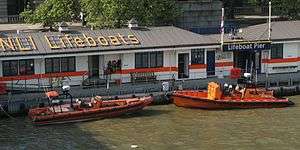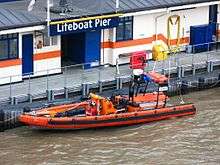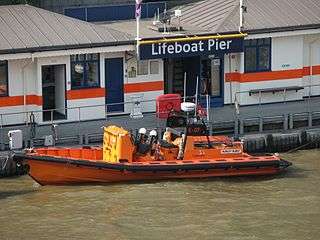E-class lifeboat
 Mark I E-002 (left) and Mark II E-07 (right) at Tower Lifeboat Station | |
| Class overview | |
|---|---|
| Name: | E-class |
| Operators: |
|
| In service: | 2002–present |
| Completed: | 9 |
| Active: | 5 |
| Preserved: | 1 |
| General characteristics | |
| Displacement: | 3.86 tonnes / 5.4 tonnes |
| Length: | 9 m (30 ft) / 10.5 m (34 ft) |
| Beam: | 2.94 m (9.6 ft) / 3.5 m (11 ft) |
| Draught: | 0.67 m (2.2 ft) / 0.7 m (2.3 ft) |
| Propulsion: | Diesel powered waterjets |
| Speed: | 33 knots (61 km/h) / 40 knots (74 km/h) |
| Endurance: | 4 hours / 3 hours |
| Capacity: | 20 |
| Complement: | 3 / 4 |
The E-class lifeboat forms part of the RNLI fleet in the United Kingdom, operating exclusively in the tidal reach of the River Thames in London. The class was introduced in 2002 to serve the tidal reach of the River Thames, which had not previously been covered by an RNLI rescue service, as a result of a much delayed enquiry into the Marchioness disaster in 1989, in which 51 people died. The enquiry criticised the lack of a rescue service for the tidal Thames, and the UK government asked the Maritime and Coastguard Agency, the Port of London Authority and the RNLI to work together to set up a dedicated Search and Rescue service for this stretch of the river.[1][1][2]
There are two different versions of the E-class, described as the mark I and mark II. The original intention was that the mark II boats would replace the mark Is, but building of the last two mark Is has been put on hold and there are currently two mark Is and three mark IIs in use, split between Chiswick Lifeboat Station to the west of central London, and Tower Lifeboat Station at Victoria Embankment in central London.[3][4] An E-class boat also originally operated from Gravesend Lifeboat Station to the east of London, but it proved less suitable for the more estuarine conditions found there and was replaced in 2009 with an Atlantic 85.
Both versions of the E-class carry a variety of rescue equipment including marine VHF radios, a first aid kit, an emergency defibrillator, a GPS navigation system, night vision equipment, a self-righting system, a radar interrogator, towing equipment, and lighting equipment.[1][3]
Mark I

The mark I boat was an off the shelf design built by Tiger Marine. It is made of an aluminium alloy with a closed cell polythene foam collar, and is powered by two Steyr marine diesel engines delivering 240 horsepower (180 kW) each at 4,100rpm and driving Hamilton waterjets. This combination gives the boats a maximum speed of 33 knots (38 mph; 61 km/h) and the extreme maneuverability which is essential to enable crews to reach casualties in the fast flowing river. The boat is 9 metres (30 ft) long, has a beam of 2.94 metres (9 ft 8 in), a draft of 0.64 metres (2 ft 1 in), a displacement of 3.86 tonnes (3.80 long tons; 4.25 short tons), and carries three crew. The maximum endurance at full speed is 4 hours.[1][3][4]
| Op. No.[lower-alpha 1] | Name | In service | Principal Station | Comments |
|---|---|---|---|---|
| E-001 | Public Servant (Civil Service No.44) | 2002–2005 2005–2012 |
Tower Relief fleet |
Damaged beyond repair, currently in Ipswich ready for scrap. |
| E-002 | Olivia Laura Deare | 2002–2009 2009–2012 |
Gravesend Relief fleet |
On display at Chatham Historic Dockyard from 2012 |
| E-003 | Chelsea Pensioner | 2002–2015 | Chiswick | |
| E-004 | Ray and Audrey Lusty | 2002–2012 | Tower | |
| E-005 | Legacy | 2002–present | Tower | |
| E-006 | Joan and Ken Bellamy | 2005–present | Chiswick |
Mark II

The mark II boat was designed by RNLI engineers, incorporating experience gained with the mark I boats, and built by Marine Specialised Technology in Liverpool. It has a glass epoxy-resin composite hull with a detachable polyurethane covered solid closed-cell foam collar, and is powered by two Volvo marine diesel engines delivering 435 horsepower (324 kW) each at 3,300rpm and driving Hamilton waterjets. This combination gives the boats an improved maximum speed of 40 knots (46 mph; 74 km/h). The boat is 10.5 metres (34 ft) long, has a beam of 2.9 metres (9 ft 6 in) without collar and 3.5 metres (11 ft) with collar, a draft of 0.7 metres (2 ft 4 in), a displacement of 5.4 tonnes (5.3 long tons; 6.0 short tons), and carries carries four crew. The maximum endurance at full speed is 3 hours.[1][3]
| Op. No.[lower-alpha 1] | Name | In service | Principal Station | Comments |
|---|---|---|---|---|
| E-07 | Hurley Burly | 2011–present | Tower | |
| E-08 | Dougie and Donna B | 2012–present | Chiswick | [5][6] |
| E-09 | Brawn Challenge | 2012–present | Relief fleet | [5][6] |
Other
The RNLI also had a valiant RIB which was allocated the fleet number E-01.[7]
| Op. No.[lower-alpha 1] | Name | In service | Principal Station |
|---|---|---|---|
| E-01 | Valiant RIB | 2001–2003 | Enniskillen |
Notes
References
- 1 2 3 4 5 "The fleet - E class". Royal National Lifeboat Institution. Archived from the original on 26 August 2010. Retrieved 18 August 2010.
- ↑ "Thames lifeboat service launched". BBC News. 2 January 2002. Retrieved 17 May 2010.
- 1 2 3 4 "E class lifeboat". RNLI. Archived from the original on 21 July 2017. Retrieved 21 July 2017.
- 1 2 "E-class Fast Response Craft". Lifeboat World On-Line. Archived from the original on 21 July 2017. Retrieved 21 July 2017.
- 1 2 "E class update". RNLI. Archived from the original on 29 December 2012. Retrieved 11 April 2012.
- 1 2 The Lifeboat Magazine. RNLI. Spring 2012. p. 19.
- ↑ Inshore Lifeboat Fleet Archive. RNLI HQ, Poole: RNLI. p. 68.
|access-date=requires|url=(help)
External links
| Wikimedia Commons has media related to E-class lifeboat. |